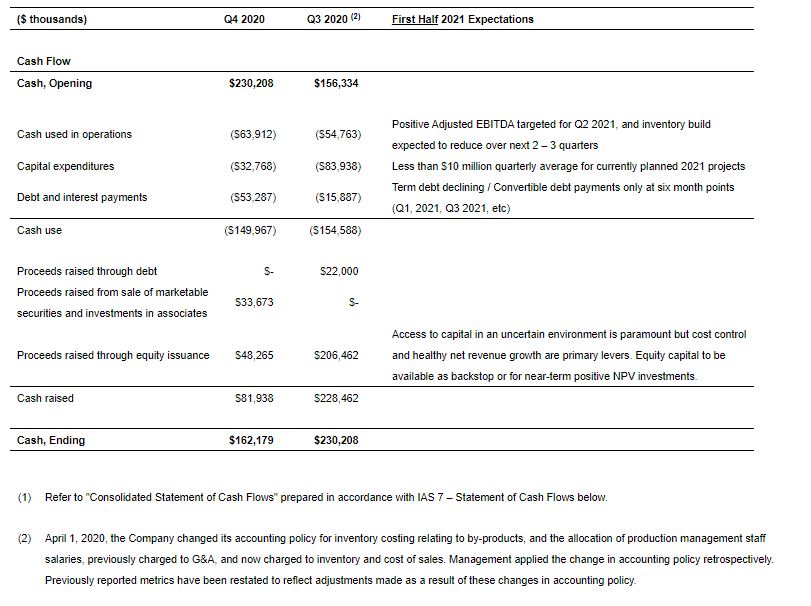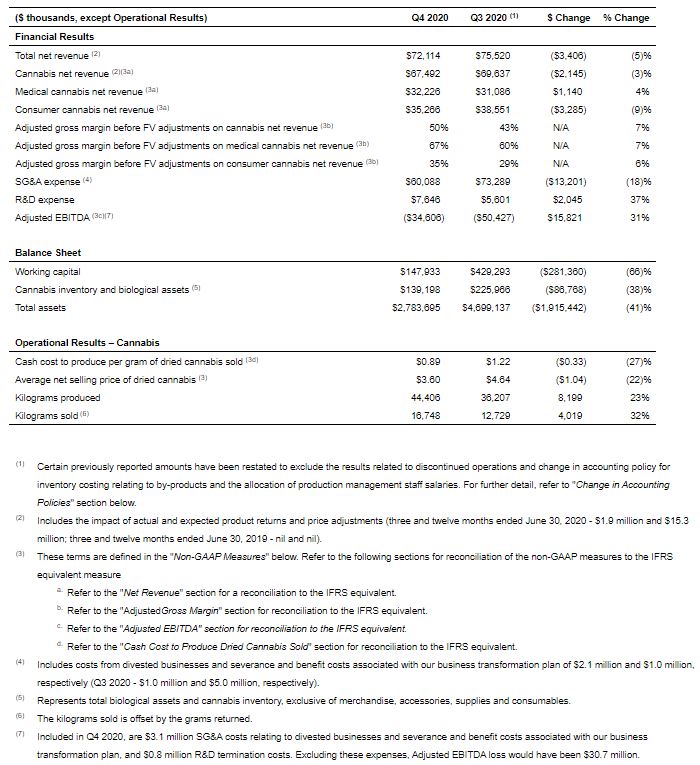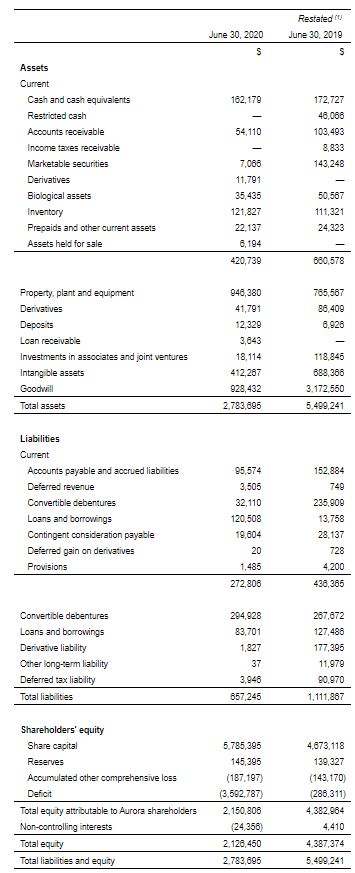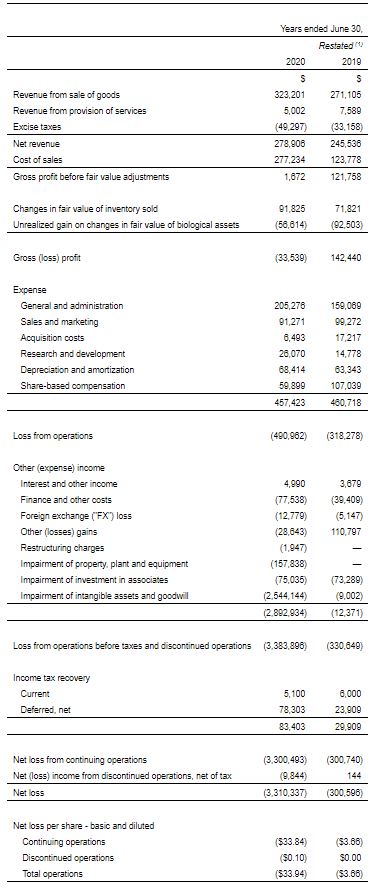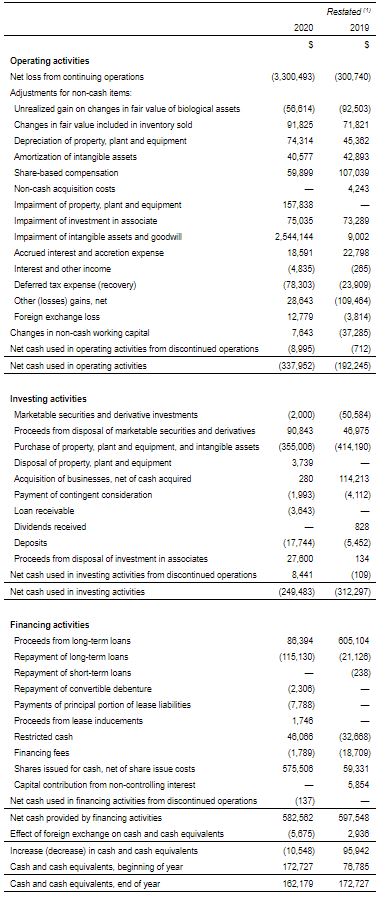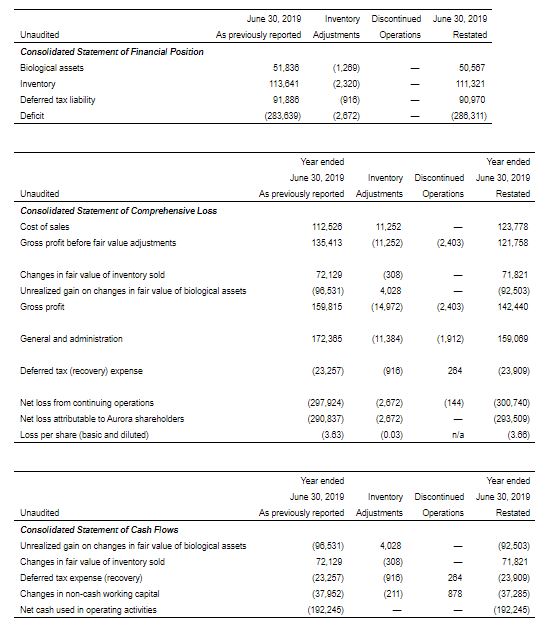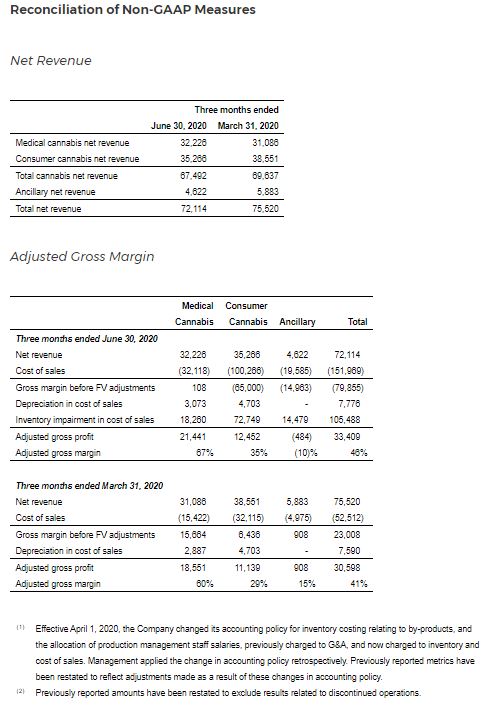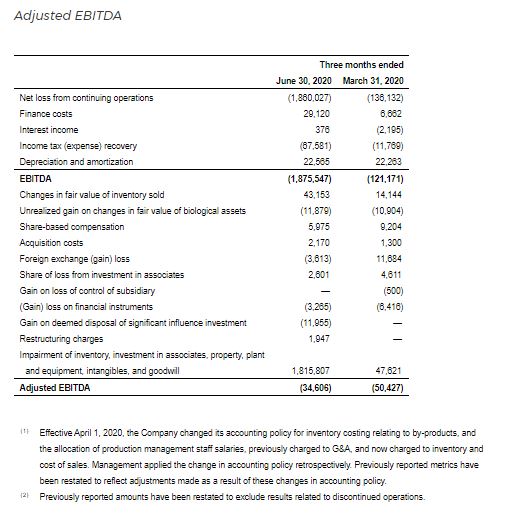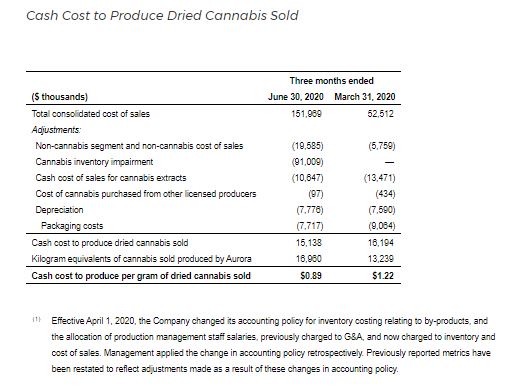
Aurora Cannabis Announces Fiscal Fourth Quarter 2020 Results
- Continued Adjusted EBITDA Improvement Due to Strong Gross Margins and Reduced SG&A
- Debt Levels and CapEx Spend Down Substantially in Q4 2020
- Provides Guidance for Q1 2021
NYSE | TSX: ACB
EDMONTON, AB, Sept. 22, 2020 /PRNewswire/ – Aurora Cannabis Inc. (the “Company” or “Aurora”) (NYSE | TSX: ACB), the Canadian company defining the future of cannabinoids worldwide, today announced its financial and operational results for the fourth quarter of fiscal 2020 ended June 30, 2020.
“As reported in our September 8, 2020 business update, our Q4 demonstrated progress in rationalization of SG&A and cash burn along with continued leadership in both Canadian and international medical. However, Aurora has slipped from its top position in Canadian consumer, a market that continues to support material growth and opportunity,” stated Miguel Martin, recently appointed Chief Executive Officer of Aurora. “My focus is therefore to re-position the Canadian consumer business immediately. We look to expand beyond the value flower segment, leverage our capabilities in science and product innovation and put our effort on a finite number of emerging growth formats. This entails prioritizing our San Rafael, Aurora and Whistler premium brands in flower, pre-rolls and vapor, which will be shortly followed by strategic marketing and innovation efforts in concentrates and edibles.”
I accepted the CEO role because I see an opportunity to utilize my skill set in regulated CPG brand development. I am fortunate to have stepped into a Company built with a dedication to science and a compliance first approach. Through successful execution, I believe what we build in Canada will be very portable to other larger global cannabinoid markets.
 Miguel Martin, Chief Executive Officer of Aurora
Miguel Martin, Chief Executive Officer of Aurora
Having now spent four months at Aurora, I have seen the talent and industry knowledge that makes this Company innovative and agile. I want Aurora to be a leader in cannabinoids when the largest markets open up globally and my job is to make sure we can deliver on that plan.
Fourth Quarter 2020 Highlights
(Unless otherwise stated, comparisons are made between fiscal Q4 2020 and Q3 2020 results and are in Canadian dollars. Certain key metrics in prior quarters have been restated to reflect accounting policy changes for inventory costing and the allocation of production staff salaries. See Change in Accounting Policy section below)
Q4 2020 total net revenue was $72.1 million, a 5% decrease from the prior quarter. Cannabis net revenue¹ was $67.5 million in Q4 2020, a 3% decrease from the prior quarter. Adjusted gross margin, before FV adjustments, on cannabis net revenue¹ was 50%, up from 43% in Q3.
Consumer cannabis:
- Consumer cannabis net revenue¹ was $35.3 million, a decrease of 9% over the previous quarter. Total volume of dried consumer cannabis sold increased by 36%, but was offset by a 30% decrease in the average net selling price per gram of consumer cannabis¹ as the Company’s value segment brand, Daily Special, accounted for a greater percentage of consumer cannabis net revenue, at 62% of flower revenue compared to 35% in the prior quarter. Consumer cannabis extract net revenue decreased by $1.5 million as compared to the prior quarter driven primarily by a loss of market share for vaporizer products.
- Adjusted gross margin, before fair value adjustments on consumer cannabis net revenue¹ was 35% in Q4 2020, versus the 29% in the prior quarter. Despite the pressure on average selling price (“ASP”) in this segment, continued per-unit reductions in production costs supported a healthy average margin.
Medical cannabis:
- Medical cannabis net revenue¹ was $32.2 million, a 4% increase from the prior quarter. The increase was primarily attributable to a sustainable and profitable Canadian medical business growing by 2% and strong traction in Europe growing by 14% quarter over quarter.
- Adjusted gross margin, before fair value adjustments of medical cannabis net revenue¹ was 67% in Q4 2020, versus the 60% in the prior quarter. The medical cannabis segment continues to benefit from the Company’s leading share of the Canadian and European medical markets, with strong average net selling price of medical cannabis¹ and continued per unit production cost reductions.
Selling, General and Administrative (“SG&A”) and Adjusted EBITDA:
- SG&A, including Research and Development (“R&D”), was $67.7 million in Q4 2020, down $11.2 million from the prior quarter as a result of the Company’s Business Transformation Plan. Included in SG&A is $3.9 million of costs related to divested businesses, R&D termination costs and severance and benefit costs associated with the Business Transformation Plan. Excluding these impacts, Q4 SG&A was $63.8 million.
- Adjusted EBITDA¹ in Q4 2020 was a loss of $34.6 million, an improvement of $15.8 million from the prior quarter Adjusted EBITDA loss of $50.4 million. Excluding severance costs, R&D termination costs and divested business results, Q4 Adjusted EBITDA was a loss of $30.7 million.
Additional Highlights:
- Production volume in Q4 2020 was 44,406 kilograms, a 23% increase from the prior quarter, contributing to a 27% decrease in cash cost to produce per gram of dried cannabis sold¹ quarter over quarter.
- Capital Expenditures (“CapEx”) were approximately $16.4 million in Q4 2020, a significant decline from the $73.7 million reported in Q3 2020, as the Company’s business transformation continued to deliver concrete results. This includes additions to intangible assets and excludes the impact of capitalized borrowing costs and share based compensation.
- Aurora recorded a number of balance sheet adjustments in Q4 2020 to recognize market realities and position the Company for future performance. These adjustments include fixed asset impairment charges of $86.5 million due to production facility rationalization, and a charge of $135.1 million in the carrying value of certain inventory, predominantly trim, in order to align inventory on hand with near term expectations for demand. Of the $135.1 million inventory impairment, $105.5 million is recognized through cost of sales and $29.6 million is recognized through changes in fair value of inventory sold on the statements of comprehensive loss. Finally, the Company recognized a non-cash write-down of goodwill and intangible assets of $1.6 billion.
_____________________
1 These terms are non-GAAP measures, see “Non-GAAP Measures” below.
Fiscal Q4 2020 Cash Use:
Significant Reduction in CapEx levels and Adjusted EBITDA Loss. Term Debt Paid Down Substantially.
Cash use in Q4 2020 was similar to the prior quarter, however the mix within the use showed significant positive progress. In Q4 2020, Aurora used $53.3 million cash to pay down term debt and lease obligations, and following further paydowns subsequent to the quarter end, term debt stands at $110.5 million as of September 21, 2020. Cash used for capital expenditures was $32.8 million, which includes invoices paid related for work done in Q3, and was $51.2 million lower than in Q3. Cash used in operations was $63.9 million, excluding the $105.5 million of non-cash inventory impairment in cost of sales (see “Additional Highlights” above).
Given the Company’s continued strength in adjusted gross margins before fair value adjustments on cannabis net revenue and further reductions in SG&A expense and capital expenditures as described above, management expects cash use in fiscal Q1 2021 to further decrease.
The main components of cash source and use in Q4 2020 were as follows:
Q4 2020 Key Financial and Operational Metrics
Events Subsequent to Quarter End
- Miguel Martin was appointed Chief Executive Officer, effective September 8, 2020. With deep, diverse experience in consumer packaged goods, highly regulated industries and the U.S. cannabinoid industry, Miguel is well-positioned to execute the next phase of Aurora’s business transformation, with a focus on commercial strategy. Michael Singer, who served as Interim CEO beginning February 2020, stepped down from his temporary role and remains Executive Chairman.
- In a press release on September 8, 2020, Aurora provided a business update, including the following announcements:
- The Company is now operating at its quarterly SG&A run-rate in the low $40 million range, and expects operational cost reductions from facility closures up to $10 million per quarter starting in the second half of fiscal 2021. With a tailwind of growth in the Canadian recreational market, the Company is better positioned for its next phase focused on profitability.
- Aurora and the UFC have agreed to mutually terminate their partnership. For the Company, this decision reflects the evolution of the realities of the cannabis market and a focus on near term profit pools. In connection with this decision, the Company expects to make a one-time payment of US$30 million to terminate the contract in Q1 2021, which is expected to avoid more than $150 million in fees, research costs, and marketing activation expenses over the next five years.
- Aurora reached an agreement with its syndicate of banks regarding amendments to its secured credit agreement. These amendments have provided additional flexibility during the Company’s Business Transformation Plan.
- Effective immediately, Dr. Jason Dyck has elected to step down from the Board of Directors in order to pursue other opportunities.
Subsequent to June 30, 2020, the Company raised US$36.6 million gross proceeds under its ATM program, with approximately US$183 million of remaining available room under the ATM and approximately US$60.0 million of remaining available room under the Shelf Prospectus for future financings or issuances of securities.
Guidance
Following the divestiture of non-core subsidiaries during fiscal 2020, net revenue in Q1 2021 is expected to be comprised exclusively of cannabis net revenue. Cannabis net revenue is expected to be between $60 million and $64 million, compared to $67.5 million in Q4 2020. The Company expects adjusted gross margin before fair value adjustments on cannabis net revenue to be within a range of 46%-50% and SG&A costs (including R&D) in the low $40 million range.
As a reminder, the Company expects to achieve positive Adjusted EBITDA in Q2 2021.
Conference Call
Aurora will host a conference call today, September 22, 2020, to discuss these results. Miguel Martin, Chief Executive Officer, and Glen Ibbott, Chief Financial Officer, will host the call starting at 5:00 p.m. Eastern time. A question and answer session will follow management’s presentation.
DATE: Tuesday, September 22, 2020
TIME: 5:00 p.m. Eastern Time | 3:00 p.m. Mountain Time
WEBCAST: http://public.viavid.com/index.php?id=141462
REPLAY: (844) 512-2921 or (412) 317-6671
Available until 11:59 p.m. Eastern Time Tuesday, October 6, 2020
PIN NUMBER: 13710020
About Aurora
Aurora is a global leader in the cannabis industry serving both the medical and consumer markets. Headquartered in Edmonton, Alberta, Aurora is a pioneer in global cannabis dedicated to helping people improve their lives. The Company’s brand portfolio includes Aurora, Aurora Drift, San Rafael ’71, Daily Special, AltaVie, MedReleaf, CanniMed, Whistler, and Reliva. Providing customers with innovative, high-quality cannabis and hemp products, Aurora’s brands continue to break through as industry leaders in the medical, performance, wellness and recreational markets wherever they are launched. For more information, please visit our website at www.auroramj.com.
Aurora’s Common Shares trade on the TSX and NYSE under the symbol “ACB”, and is a constituent of the S&P/TSX Composite Index.
Non-GAAP Measures
The Company uses certain financial performance measures that are not recognized or defined under IFRS (termed “Non-GAAP Measures”). As a result, this data may not be comparable to data presented by other licensed producers of cannabis and cannabis companies. For an explanation of these measures to related comparable financial information presented in the consolidated financial statements prepared in accordance with IFRS, refer to the discussion below. The Company believes that these Non-GAAP Measures are useful indicators of operating performance and are specifically used by management to assess the financial and operational performance of the Company. These Non-GAAP Measures include, but are not limited, to the following:
- Cash cost to produce dried cannabis sold is calculated by taking the cost of sales, excluding the effect of changes in the FV of biological assets and inventory, and deducting non-cash production costs, cannabis extract conversion costs, cost of accessories, cost of products purchased from other Licensed Producers that were sold, cost of sales from non-cannabis producing subsidiaries, inventory impairments, and packaging costs (i.e. post-production costs). Cash cost to produce per gram of dried cannabis sold is calculated by taking cash cost to produce dried cannabis sold divided by total grams of dried cannabis sold in the period that was produced by Aurora. Management believes these measures provide useful information about the efficiency of our production of cannabis.
- Cannabis net revenue represents revenue from the sale of cannabis products, excluding excise taxes and net revenue from patient counseling services, design, engineering and construction services, sale of hemp products, and analytical testing services. Cannabis net revenue is further broken down as follows:
- Medical cannabis net revenue represents Canadian and international cannabis net revenue for medical cannabis sales only, excluding wholesale bulk cannabis net revenue.
- Consumer cannabis net revenue represents cannabis net revenue for consumer cannabis sales only.
Management believes the cannabis net revenue measures provide more specific information about the net revenue purely generated from our core cannabis business and by market type.
- Average net selling price per gram and gram equivalent is calculated by taking cannabis net revenue divided by total grams and grams equivalent of cannabis sold in the period. Average net selling price per gram and gram equivalent is further broken down as follows:
- Average net selling price per gram of dried cannabis represents the average net selling price per gram for dried cannabis sales only, excluding wholesale bulk cannabis sold in the period.
- Average net selling price per gram and gram equivalent of consumer cannabis represents the average net selling price per gram and gram equivalent for dried cannabis and cannabis extracts sold in the consumer market.
Management believes the average net selling price per gram or gram equivalent measures provide more specific information about the pricing trends over time by product and market type.
- Adjusted gross profit before FV adjustments on cannabis net revenue represents cash gross profit and gross margin on cannabis net revenue and is calculated by subtracting from total cannabis net revenue (i) cost of sales, before the effects of changes in FV of biological assets and inventory; (ii) cost of sales from non-cannabis auxiliary support functions; and removing (iii) depreciation in cost of sales; and (iv) cannabis inventory impairment. Adjusted gross margin before FV adjustments on cannabis net revenue is calculated by dividing adjusted gross profit before FV adjustments on cannabis net revenue divided by cannabis net revenue. Adjusted gross profit and gross margin before FV adjustments on cannabis net revenue is further broken down as follows:
- Adjusted gross profit and gross margin before FV adjustments on medical cannabis net revenue represents adjusted gross profit and gross margin before FV adjustments on sales generated in the medical market only.
- Adjusted gross profit and gross margin before FV adjustments on consumer cannabis net revenue represents adjusted gross profit and gross margin before FV adjustments on sales generated in the consumer market only.
Management believes that these measures provide useful information to assess the profitability of our cannabis operations as it represents the cash gross profit and margin generated from cannabis operations and excludes the effects of non-cash FV adjustments on inventory and biological assets, which are required by IFRS.
- Adjusted EBITDA is calculated as net (loss) income excluding interest income (expense), accretion, income taxes, depreciation, amortization, changes in fair value of inventory sold, changes in fair value of biological assets, share-based compensation, acquisition costs, foreign exchange, changes in fair value of financial instruments, gains and losses on deemed disposal, and non-cash impairment of intangibles, goodwill, inventory, property, plant and equipment and other assets. Adjusted EBITDA is intended to provide a proxy for the Company’s operating cash flow and is widely used by industry analysts to compare Aurora to its competitors, and derive expectations of future financial performance for Aurora. Adjusted EBITDA increases comparability between comparative companies by eliminating variability resulting from differences in capital structures, management decisions related to resource allocation, and the impact of FV adjustments on biological assets and inventory and financial instruments, which may be volatile and fluctuate significantly from period to period.
Non-GAAP measures should be considered together with other data prepared accordance with IFRS to enable investors to evaluate the Company’s operating results, underlying performance and prospects in a manner similar to Aurora’s management. Accordingly, these non-GAAP measures are intended to provide additional information and should not be considered in isolation or as a substitute for measures of performance prepared in accordance with IFRS.
Consolidated Statements of Financial Position
(Amounts reflected in thousands of Canadian dollars, unaudited)
(1) Effective April 1, 2020, the Company changed its accounting policy for inventory costing relating to by-products, and the allocation of production management staff salaries, previously charged to G&A, and now charged to inventory and cost of sales. Management applied the change in accounting policy retrospectively. Previously reported metrics have been restated to reflect adjustments made as a result of these changes in accounting policy.
Consolidated Statements of Profit and Loss
(Amounts reflected in thousands of Canadian dollars, except share and per share amounts, unaudited)
(1) Effective April 1, 2020, the Company changed its accounting policy for inventory costing relating to by-products, and the allocation of production management staff salaries, previously charged to G&A, and now charged to inventory and cost of sales. Management applied the change in accounting policy retrospectively. Previously reported metrics have been restated to reflect adjustments made as a result of these changes in accounting policy.
Consolidated Statements of Cash Flows
(Amounts reflected in thousands of Canadian dollars, unaudited)
(1) Effective April 1, 2020, the Company changed its accounting policy for inventory costing relating to by-products, and the allocation of production management staff salaries, previously charged to G&A, and now charged to inventory and cost of sales. Management applied the change in accounting policy retrospectively. Previously reported metrics have been restated to reflect adjustments made as a result of these changes in accounting policy.
Change in Accounting Policy
Effective April 1, 2020, the Company elected to change its accounting policy for inventory costing of by-products. The process of growing and harvesting dried cannabis produces trim, which is now considered to be a by-product. Inventories of harvested cannabis, which now excludes trim, are transferred from biological assets to inventory at fair value less costs to sell at the point of harvest, which becomes the deemed cost. Historically, the Company pro-rated this deemed cost of inventory based on the total grams harvested. The Company now measures by-products at their net realizable value at point of harvest and deducts this value from the total deemed cost to derive a net cost for the main product. Additionally, the Company has elected to change its accounting policy with respect to the allocation of production management staff salaries, previously charged to general administrative expense, and now charged to inventory and cost of sales. The Company now allocates and capitalizes a portion of these salaries to inventory as opposed to expensing them directly in sales and marketing, and general and administrative expenses. The Company believes that the revised policies and presentation provides more accurate and relevant financial information to users of the consolidated financial statements. See Note 9 for the Company’s revised accounting policy on inventory costing.
Management has applied the change in accounting policy retrospectively. The consolidated financial statements for the year ended June 30, 2019 have been restated to reflect adjustments made as a result of this change in accounting policy. The following is a summary of the impacts to the statement of financial position, the statement of comprehensive loss, and the statement of cash flows for the year ended June 30, 2019:

